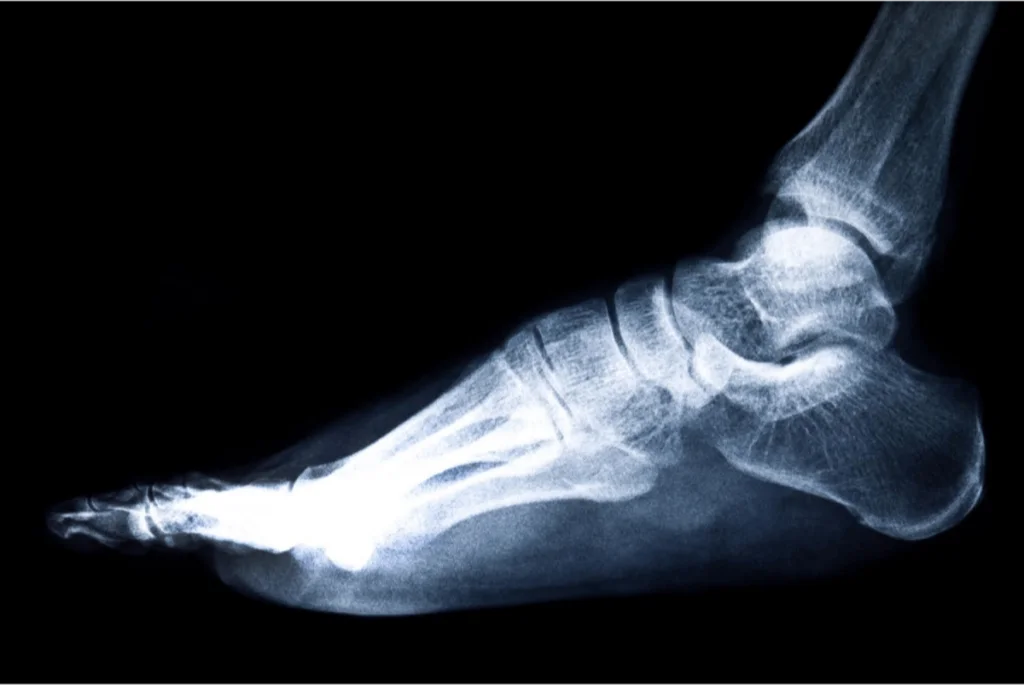Many people face foot and ankle problems but aren’t sure when to seek help. Conditions like plantar fasciitis or ingrown toenails can make daily life hard, and that’s where podiatrists come in, who are the experts that can get you back on your feet!
What is a Podiatrist?
A podiatrist is a specialized medical professional who focuses on diagnosing and treating foot and ankle conditions using advanced diagnostic tools and techniques.
Podiatrist, foot doctor, or Doctor of Podiatric Medicine (DPM), they all mean the same thing which is a medical professional who specializes in treating the foot, ankle, and lower leg. Podiatrists aren’t traditional medical doctors, but they have their own specialized education and training. They can perform surgeries, set broken bones, prescribe medications, and order lab tests or X-rays.

Conditions Treated By Podiatrist
Podiatrists handle many foot and ankle problems. They treat common issues like bunions, hammertoes, and ingrown toenails. If you have heel pain or plantar fasciitis, a podiatrist can help you get relief. They also manage more serious conditions like foot complications from diabetes, arthritis, and fractures. Sports injuries, such as ankle sprains and Achilles tendon ruptures, are also areas where they can help.
Podiatrist Diagnostic Tools
Podiatrists use a variety of advanced tools. X-rays are used to examine bone issues and take about ten minutes to complete. For soft tissue problems, they might use ultrasound or musculoskeletal ultrasonography. Some offices have advanced equipment like digital X-rays for faster and more detailed diagnoses. The Smart ABI test helps detect blockages in leg arteries while the Clarifi Imaging System assesses blood flow without using radiation. For precise diagnoses and procedure guidance, podiatrists may use OrthoScan, which provides real-time imaging.

Common Reasons to See a Podiatrist
Seeing a podiatrist is important for addressing various foot and ankle issues. From pain and injuries to deformities, they make sure you get proper care and prevent long-term complications.
Foot Pain That Needs A Podiatrist
You might need to see a podiatrist if you feel pain in your feet, ankles, or lower back. Foot and ankle pain can stem from various issues like tendonitis, fractures, or sprains. Lower back pain can sometimes be linked to foot problems. If you wake up with persistent heel pain, it could be plantar fasciitis, which requires proper diagnosis.
Foot and Ankle Injuries
Foot and ankle injuries are common reasons to visit a podiatrist. About 23,000 people in the United States sprain their ankles badly enough every day to need medical attention. If you’ve injured your ankle and it hurts to step on it, or if there’s swelling and discoloration, you should seek care. Even mild sprains need proper treatment to prevent future complications and reduce the risk of re-injury.

Foot Deformities
Foot deformities can lead to pain and make daily life more difficult. Common issues include bunions, hammertoes, and flat feet. Bunions often develop from wearing shoes that don’t fit well. Hammertoes usually affect the second toe, causing it to bend in a hammer-like shape. Flat feet can lead to additional foot problems if not treated. A podiatrist can offer a range of treatments, from non-surgical care to surgical options, to address these deformities. Early intervention is important because the sooner you consult a podiatrist, the more effective your treatment options will be.
Foot Pain Treatments
Podiatrists offer a variety of specialized treatments, ranging from conservative approaches to advanced surgical interventions and regenerative medicine techniques.
Conservative Approaches
When you see a podiatrist, they start with simple treatments to help your foot and ankle problems without needing surgery. They might suggest custom bracing and splinting. Another option is physical therapy, where exercises are used to make your feet stronger. To help with pain, they might recommend ice or heat therapy, where you apply ice or heat packs for about 15 minutes.
Surgical Solutions For Foot Pain
Sometimes, basic treatments might not be enough to relieve your foot pain. In these cases, your podiatrist may suggest surgery. For example, there are different types of bunion surgeries depending on how severe your condition is. If you have a hammer toe, surgery might involve removing part of the bone to straighten the toe or fusing the joints together. For ongoing problems like arthritis, your podiatrist might recommend a fusion, where cartilage is removed, and two or more bones are joined. If you have a heel spur causing chronic pain, surgery like a plantar fascia release could help.

Regenerative Medicine For Feet
Regenerative medicine focuses on replacing damaged tissue with healthy cells to spur your body’s natural healing process. One popular treatment is platelet-rich plasma (PRP) therapy. This involves injecting a concentration of your own platelets into the affected area to accelerate healing. Another approach is amniotic cell therapy. This treatment uses cells from amniotic tissues to promote tissue growth and reduce inflammation. It has shown promise in treating conditions like Achilles tendinitis, plantar fasciitis, and chronic heel pain.
Foot Care for Specific Demographics
Foot care is customized to meet the needs of different groups such as athletes, diabetics, and the elderly.
Athletes With Foot Pain
Sports podiatrists are key to an athlete’s care as they focus on preventing and treating foot injuries common in sports. They understand the strain that sports put on feet and lower legs, handling both sudden injuries like sprains and ongoing issues like tendinitis. Athletes can protect their feet by wearing sport-specific shoes, choosing moisture-wicking socks, replacing worn-out shoes, resting between workouts, and keeping their feet clean. Sports podiatrists also give advice on the right shoes and inserts to help athletes perform their best.

Diabetics With Feet Problems
Diabetes can cause serious foot problems, so people with diabetes should monitor their feet for warning signs like color changes, swelling, numbness, and slow-healing sores. Podiatrists are important in detecting and treating these diabetes-related foot issues through yearly exams that assess pulses, sensation, and foot structure, helping to identify problems early and avoid complications.
Elderly Foot Pain
As seniors age, they encounter foot and ankle problems like foot ulcers, ingrown toenails, fallen arches, and fungal infections. The natural deterioration of foot fat makes them more vulnerable to these issues. To maintain foot health, seniors should inspect their feet, keep them clean and dry, and wear properly fitting shoes with good support. Regular foot inspections are vital for those with conditions like diabetes or poor blood circulation as these can increase the risk of foot problems.

Do You Need To See A Podiatrist?
Seeing a podiatrist can be helpful for maintaining good foot health and addressing issues before they become serious. Regular check-ups are a good idea, but if you experience persistent pain, unusual swelling, or numbness, it’s important to seek professional care sooner. Staying proactive about foot health, especially if you have underlying conditions like diabetes, can help prevent bigger problems down the road.
Victoria Foot & Ankle is a leading podiatry clinic in Victoria, Texas, dedicated to providing care for foot and ankle conditions. Our experienced team of podiatrists offers personalized treatment plans to address a wide range of issues, from common foot pain to complex surgical needs. We are committed to improving our patients’ quality of life through compassionate care and advanced medical techniques. Whether you need routine foot care or specialized treatment, Victoria Foot & Ankle is here to help you stay on your feet. For more information, please visit Victoria Foot & Ankle.
FAQs
What are the signs that I should visit a podiatrist?
You should consider seeing a podiatrist if you experience any of the following: pain in your feet, discoloration or redness, swelling, a sensation of warmth, or if you notice new growths or bumps on or under your skin.
What are common conditions treated by podiatrists?
Podiatrists frequently address various foot-related issues, including bunions, heel pain, ingrown toenails, and athlete’s foot. Their treatment approaches may include the use of orthotic devices, braces, or even surgery, depending on the specific condition.
Do podiatrists provide toenail cutting services?
Yes, podiatrists commonly help with toenail care. Cutting toenails might seem straightforward, but many individuals have conditions that make it difficult or impossible to do safely without professional assistance.
Why do individuals choose to be a podiatrist?
Many choose to be podiatrists because it is a profession where they can make an impact on people’s lives. Podiatrists often provide pain relief, improve mobility, and help the overall quality of life for their patients by fixing various foot-related issues.








